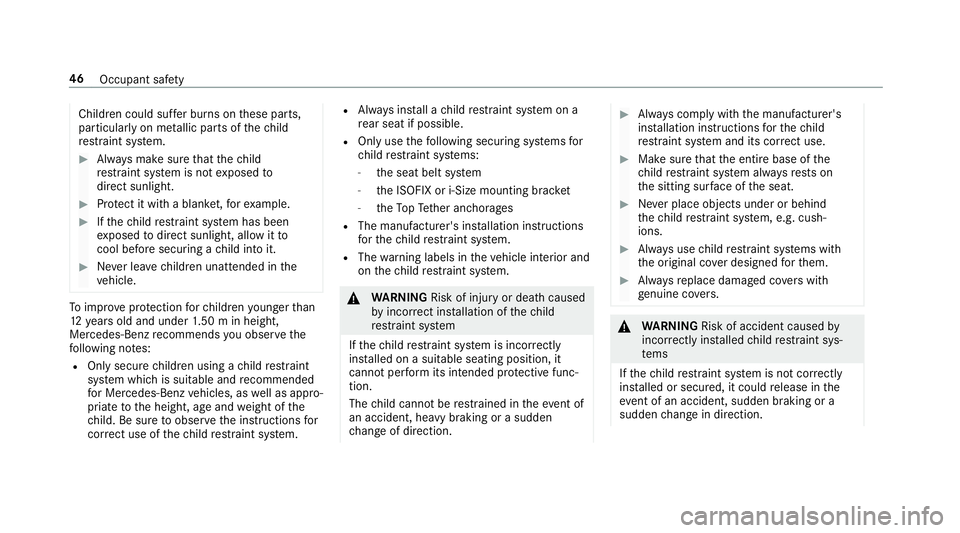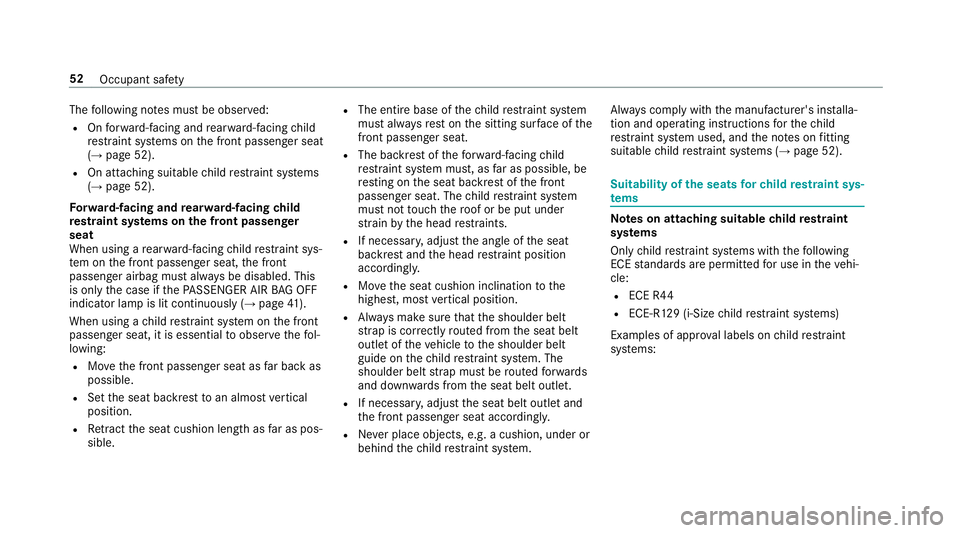2016 MERCEDES-BENZ E-CLASS SALOON tire size
[x] Cancel search: tire sizePage 49 of 557

Children could suf
fer burns on these parts,
particularly on me tallic parts of thech ild
re stra int sy stem. #
Alw ays make sure that thech ild
re stra int sy stem is not exposed to
direct sunlight. #
Protect it with a blank et,fo rex ample. #
Ifth ech ild restra int sy stem has been
ex posed todirect sunlight, allow it to
cool before secu ring a child into it. #
Never lea vechildren unat tended in the
ve hicle. To
impr oveprotection forch ildren younger than
12 years old and under 1.50 m in height,
Mercedes-Benz recommends you obse rvethe
fo llowing no tes:
R Only secure children using a child restra int
sy stem which is suitable and recommended
fo r Mercedes-Benz vehicles, as well as appro‐
priate tothe height, age and weight of the
ch ild. Be sure toobser vethe instructions for
cor rect use of thech ild restra int sy stem. R
Alw ays ins tall a child restra int sy stem on a
re ar seat if possible.
R Onlyuse thefo llowing securing sy stems for
ch ild restra int sy stems:
- the seat belt sy stem
- the ISOFIX or i-Size mounting brac ket
- theTo pTe ther anchorages
R The manufacturer's ins tallation instructions
fo rth ech ild restra int sy stem.
R The warning labels in theve hicle interior and
on thech ild restra int sy stem. &
WARNING Risk of inju ryor death caused
by incor rect ins tallation of thech ild
re stra int sy stem
If th ech ild restra int sy stem is incor rectly
ins talled on a suitable seating position, it
cannot per form its intended pr otective func‐
tion.
The child cannot be restra ined in theeve nt of
an accident, heavy braking or a sudden
ch ange of direction. #
Alw ays comply with the manufacturer's
ins tallation instructions forth ech ild
re stra int sy stem and its cor rect use. #
Makesure that the entire base of the
ch ild restra int sy stem alw aysre sts on
th e sitting sur face of the seat. #
Never place objects under or behind
th ech ild restra int sy stem, e.g. cush‐
ions. #
Alw ays use child restra int sy stems with
th e original co ver designed forth em. #
Alw aysre place damaged co vers with
ge nuine co vers. &
WARNING Risk of accident caused by
incor rectly ins talled child restra int sys‐
te ms
If th ech ild restra int sy stem is not cor rectly
ins talled or secured, it could release in the
ev ent of an accident, sudden braking or a
sudden change in direction. 46
Occupant saf ety
Page 55 of 557

The
following no tes must be obser ved:
R Onforw ard-facing and rear wa rd-facing child
re stra int sy stems on the front passenger seat
(→ page 52).
R On attaching suitable child restra int sy stems
(→ page 52).
Fo rw ard-facing and rear wa rd-facing child
re stra int sy stems on the front passenger
seat
When using a rear wa rd-facing child restra int sys‐
te m on the front passenger seat, the front
passenger airbag must alw ays be disabled. This
is only the case if thePA SSENGER AIR BAG OFF
indicator lamp is lit continuously (→ page41).
When using a child restra int sy stem on the front
passenger seat, it is essential toobser vethefo l‐
lowing:
R Movethe front passenger seat as far back as
possible.
R Set the seat backrest toan almost vertical
position.
R Retract the seat cushion length as far as pos‐
sible. R
The entire base of thech ild restra int sy stem
must alw aysre st on the sitting sur face of the
front passenger seat.
R The backrest of thefo rw ard-facing child
re stra int sy stem must, as far as possible, be
re sting on the seat backrest of the front
passenger seat. The child restra int sy stem
must not touch thero of or be put under
st ra in by the head restra ints.
R If necessar y,adjust the angle of the seat
backrest and the head restra int position
according ly.
R Movethe seat cushion inclination tothe
highest, most vertical position.
R Alw ays make sure that the shoulder belt
st ra p is cor rectly routed from the seat belt
outlet of theve hicle tothe shoulder belt
guide on thech ild restra int sy stem. The
shoulder belt stra p must be routed forw ards
and down wards from the seat belt outlet.
R If necessar y,adjust the seat belt outlet and
th e front passenger seat accordingly.
R Never place objects, e.g. a cushion, under or
behind thech ild restra int sy stem. Alw
ays comply with the manufacturer's ins talla‐
tion and operating instructions forth ech ild
re stra int sy stem used, and the no tes on fitting
suitable child restra int sy stems (→ page 52). Suitability of
the seats forch ild restra int sys‐
te ms Note
s on attaching suitable child restra int
sy stems
On lych ild restra int sy stems with thefo llowing
ECE standards are permit tedfo r use in theve hi‐
cle:
R ECE R44
R ECE-R129 (i-Size child restra int sy stems)
Examples of appr oval labels on child restra int
sy stems: 52
Occupant saf ety
Page 415 of 557

Obser
vethefo llowing when selecting, fitting and
re placing tyres:
R Countr y-specific requirements for tyre
appro valth at define a specific tyre type for
yo ur vehicle.
Fu rthermore, the use of cer tain tyre types in
cer tain regions and areas of operation can
be highly beneficial.
R Only use tyres and wheels of the same type
(summer tyres, winter tyres, MOEx tended
tyres) and the same make.
R Only fit wheels of the same size on one axle
(left and right).
It is only permissible tofit a di fferent wheel
size in theeve nt of a flat tyre in order to
drive tothe specialist workshop.
R Only fit tyres of the cor rect size onto the
wheels.
R Do not make any modifications tothe brake
sy stem, the wheels or the tyres.
The use of shims or brake dust shields is not
permitted and may in validate theve hicle's
ge neral operating pe rmit. R
Vehicles with a tyre pressure monitoring
sy stem: Allfitted wheels mu stbe equipped
with functioning sensors forth e tyre pres‐
sure monitoring sy stem.
R Attemp eratures below 7 °C, use winter tyres
or all-season tyres mar ked M+S for all
wheels.
Wi nter tyres bearing thei snowflake
symbol in addition tothe M+S marking pro‐
vide the best possible grip in wintry road
conditions.
R For M+S tyres, only use tyres with the same
tread.
R Obser vethe maximum permissible speed for
th e M+S tyres fitted.
If th is is below theve hicle's maximum speed,
th is must be indicated in an appropriate label
in the driver's field of vision.
R Run in new tyres at moderate speeds forthe
fi rs t10 0 km.
R Replace the tyres af ter six years at the latest,
re ga rdless of wear. R
When replacing with tyres that do not
fe ature run-flat characteristics: Vehicles
with MOExtended tyres are not equipped
with a TIREFIT kit at thefa ctor y.Equip the
ve hicle with a TIREFIT kit af terre placing with
tyres that do not feature run-flat characteris‐
tics, e.g. winter tyres.
Fo r more information on wheels and tyres, con‐
ta ct a qualified specialist workshop.
Be sure toalso obse rveth efo llowing fur ther
re lated subjects:
R Notes on tyre pressure (→ page 402)
R Tyre pressure table (→ page 403)
R Notes on the emer gency spa rewheel
(→ page 419) Note
s on inter changing wheels &
WARNING Risk of inju rythro ugh dif fer‐
ent wheel sizes
Inter changing the front and rear wheels if the
wheels or tyres ha vediffere nt dimensions 412
Wheels and tyres